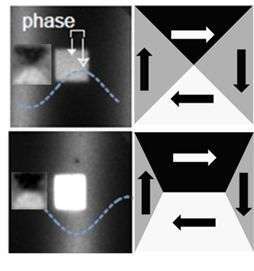Imaging how magnetism goes surfing

Using advanced dynamic imaging, researchers have been able to visualise deformation (sound) waves in crystals and measured the effect on nanomagnetic elements. This offers new low power magnetization manipulation for memory or logic applications and the methodology offers a new approach for analysing dynamic strains in other research fields: nanoparticles, chemical reactions, crystallography, etc.
Controlling the magnetic properties of materials is fundamental for developing memory, computing and communication devices at the nanoscale. As data storage and processing are evolving quickly, researchers are testing different new methods to modify magnetic properties of materials. One approach relies on elastic deformation (strain) of the magnetic material to tune its magnetic properties, which can be achieved by electric fields. This scientific area has attracted much interest due to its potential to write small magnetic elements with a low power electric field rather than magnetic fields that require high power charge currents. However, studies so far have mainly been done at very slow time scales (seconds to milliseconds).
One way to produce rapid (i.e. subnanosecond scale) changes of strain and, thus, induce magnetization changes is by using surface acoustic waves (SAWs), which are deformation (strain) waves. Now, imagine an iron rod being hammered in one side. When the rod is hit, a sound wave propagates the deformation along it. Similarly, a surface acoustic wave propagates a deformation, but only in the surface layer, similarly to waves in the ocean. In certain materials (piezoelectrics), which expand or contract when applying a voltage, SAWs can be generated through oscillating electric fields.
In a collaboration with groups from Spain, Switzerland and Berlin, the group of M. Kläui at JGU has used a new experimental technique to quantitatively image these SAW and demonstrate that they can be used to switch the magnetization in nanoscale magnetic elements (the "surfers") on top of the crystal. Results showed that the magnetic squares changed their properties under the effect of SAWs, growing or shrinking the magnetic domains depending on the phase of the SAW. Interestingly, the deformation did not occur instantaneously and the observed delay (see Figure 1) could be modelled. Understanding how the magnetic properties can be modified on a fast time scale is key to design low power magnetic devices in the future.
"For highly complex measurements, close international cooperation with leading groups and a strong Alumni network are a strategical advantage. We have teamed up with a group from the Synchrotron Radiation Source ALBA in Spain where a former PhD student from our group is working and leading this project. The work was carried out also in conjunction with a PhD student from the MAINZ Graduate School of Excellence and it is great to see that our students and alumni are so successful." emphasized Professor Mathias Kläui of the JGU Institute of Physics, who is also Director of MAINZ.
Establishment of the MAINZ Graduate School was granted through the Excellence Initiative by the German Federal and State Governments to Promote Science and Research at German Universities in 2007 and its funding was extended in the second round in 2012. It consists of work groups from Johannes Gutenberg University Mainz, TU Kaiserslautern, and the Max Planck Institute for Polymer Research in Mainz. One of its focal research areas is spintronics, where cooperation with leading international partners plays an important role.
More information: Michael Foerster et al, Direct imaging of delayed magneto-dynamic modes induced by surface acoustic waves, Nature Communications (2017). DOI: 10.1038/s41467-017-00456-0
Journal information: Nature Communications
Provided by Universitaet Mainz




















